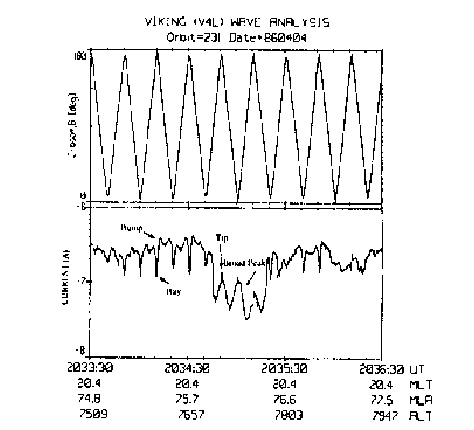


Up:
Introduction
Previous:
Langmuir probe
On high altitude orbits, e.g. the geosynchronous
one, the influence of the geomagnetic field is, in general, negligible.
As shown below, the case of low altitude polar orbits is different.
An example is provided by
the scientific Swedish satellite Viking
launched on 22 february, 1986, into a polar orbit by an Ariane rocket.
Its scientific mission
was the study of auroral and magnetospheric physics,
particulary at medium altitudes and on high-latitude field lines.
The plasma instruments included two Langmuir's probes at
the extremities of two 40 meters wire booms in the plan of spin.
On the Langmuir probe signal (shown Figure
2
) a periodic
oscillation of the current was observed
with twice the spin frequency.
When the Viking satellite crossed the auroral arc
(between 2034:45 and 2035:20), the oscillations had a maximum
when the probe-hub axis was parallel to the magnetic field line.
The phase of the oscillation indicated that this was not due to
the variation of the current of photoelectrons emission
with the orientation of the satellite with
respect to the sun ([#!DOCXVIII!#]).
So these variations was interpreted by the confinement of the
photoelectrons by the magnetic field, as in a "magnetic bottle"
([#!DOCXIII!#] and [#!DOCXVIII!#]), reaching the probe when
the boom is parallel to the magnetic field line and hereby increasing the
current.
Figure:
Example of oscillations of the current of the probe on the Swedish
Satellite Viking, extract of [#!DOCXIII!#].

|
However, another effect is expected, when the probe-boom system is
parallel to the field line.
The probe is in a kind of magnetic
wake of the hub and its current could be decreased by the fact that
the particles collected before by the hub cannot reach the
probe.
This effect is apparently at work at the edge of the auroral arc where
the minima occur when the antenna is close
to the parallel of the magnetic field.
The final effect on the probe current is the sum of these two phenomenon.
If the above interpretation is correct, the influence of the magnetic
field depends of the
angle of the boom with respect to the direction of
the magnetic field and
the induced perturbations are minimum at right angle.
In the following, the magnitude of these two effects compared to the
ideal case of a non-perturbed current is investigated for the case
when the boom is parallel to the magnetic field.
=3.0cm


Up:
Introduction
Previous:
Langmuir probe
1999-10-10